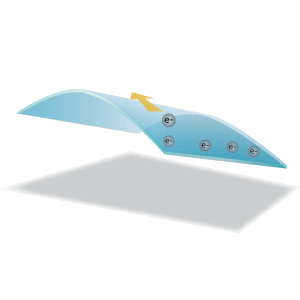 Transparent conductive films are integral components of many devices, including electrochromic glass, solar panels, and LCD and OLED displays. Today, transparent conductive films are most typically produced using indium tin oxide (ITO), a degenerately doped n-type semiconductor. ITO, however, has several crucial drawbacks. Namely: ITO is increasingly expensive due the declining availability of indium; ITO has limited environmental chemical stability, which can lead to device corrosion over time; and ITO films—by nature of how they are produced—are inevitably quite brittle.
Transparent conductive films are integral components of many devices, including electrochromic glass, solar panels, and LCD and OLED displays. Today, transparent conductive films are most typically produced using indium tin oxide (ITO), a degenerately doped n-type semiconductor. ITO, however, has several crucial drawbacks. Namely: ITO is increasingly expensive due the declining availability of indium; ITO has limited environmental chemical stability, which can lead to device corrosion over time; and ITO films—by nature of how they are produced—are inevitably quite brittle.
Demonstrated Results Using Sorted Nanotubes
Researchers at the University of California Berkeley Sensor and Actuator Center have created a channel material of solution-processed thin-films of our Iso-S semiconducting carbon nanotubes for a high-performance integrated circuit. These circuits were on mechanically flexible substrates that can be used for digital, analog, and radio frequency applications (Wang et al., Nano Lett., 2012, 12 (3), pp 1527–1533)
Researchers at Northwestern University (among others) are approaching near-ITO levels of performance with sorted, metallic CNTs in transparent conductive films. (Green, A., et al., Nano Letters (2008) 8, 1417-1422).
High Resiliency, Low Sheet Resistance
Owing to their processability, stability, and high conductivity, carbon nanotubes have received significant attention from electronics-industry researchers over the past several years as an alternative to ITO. However, development work with nanotubes has been largely precluded by the unavoidable electronic polydispersity of as-grown CNTs. NanoIntegris has effectively solved this polydispersity problem—by separating as-grown nanotubes via DGU, we can produce large quantities of uniform metallic CNTs with up to 99% purity.
Carbon Nanotube transparent conductive films have also been shown to possess the following remarkable characteristics:
- Great Performance: On-off current ratio > 104, Current density = 15µA/µm, Carrier Mobility = 60.6 cm2/(Vs), Sheet resistance < 140Ω/sq @ >70% transparency, Cut-off Frequency = 170MHz.
- Flexibility: CNT films are far more physically resilient than comparable films made from ITO and other metallic oxides.
- Tunable Transparency: DGU-sorted metallic nanotubes can be used to produce conductive films that are optimally transparent at arbitrary wavelengths.
- Stability: Transparent conductors formed from DGU-sorted metallic nanotubes do not require doping to maintain their conductivity.